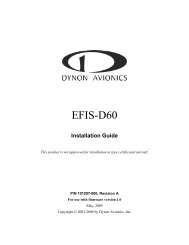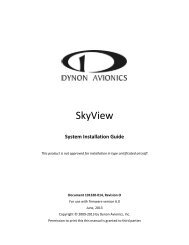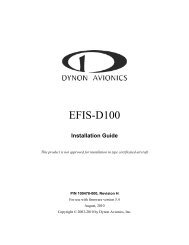- Page 3 and 4:
Contact InformationDynon Avionics,
- Page 5 and 6:
Revision Revision Date DescriptionS
- Page 7:
Revision Revision Date DescriptionA
- Page 12 and 13:
Table of ContentsEthernet Connectio
- Page 14 and 15:
Table of ContentsVP-X SkyView Displ
- Page 16 and 17:
IntroductionAbout this GuideIn the
- Page 18 and 19:
System PlanningTable 4 contains phy
- Page 20 and 21:
System PlanningSV-ADAHRS-200 and SV
- Page 22 and 23:
System PlanningThere are no module-
- Page 24 and 25:
System PlanningServos (SV32, SV42,
- Page 26 and 27:
System Planningon any one of them.
- Page 28 and 29:
System PlanningFigure 5-SkyView Sys
- Page 30 and 31:
System PlanningHSI RequirementsThe
- Page 32 and 33:
Basic SkyView Display OperationDisp
- Page 34 and 35:
Basic SkyView Display OperationA bu
- Page 36:
Basic SkyView Display OperationBasi
- Page 41 and 42:
Basic SkyView Display OperationGPS
- Page 43:
Basic SkyView Display OperationServ
- Page 46 and 47:
SV-D700 / SV-D1000 Installation and
- Page 48 and 49:
SV-D700 / SV-D1000 Installation and
- Page 50 and 51:
SV-D700 / SV-D1000 Installation and
- Page 52 and 53:
SV-D700 / SV-D1000 Installation and
- Page 54 and 55:
SV-D700 / SV-D1000 Installation and
- Page 56 and 57:
SV-D700 / SV-D1000 Installation and
- Page 58 and 59:
SV-D700 / SV-D1000 Installation and
- Page 60 and 61:
SV-D700 / SV-D1000 Installation and
- Page 62 and 63:
SV-D700 / SV-D1000 Installation and
- Page 64 and 65:
SV-D700 / SV-D1000 Installation and
- Page 66 and 67:
SV-ADAHRS-20X Installation and Conf
- Page 68 and 69:
SV-ADAHRS-20X Installation and Conf
- Page 71 and 72:
SV-ADAHRS-20X Installation and Conf
- Page 73:
SV-ADAHRS-20X Installation and Conf
- Page 76 and 77:
SV-ADAHRS-20X Installation and Conf
- Page 78 and 79:
SV-ADAHRS-20X Installation and Conf
- Page 81 and 82:
7. SV-EMS-220 Installation and Conf
- Page 83 and 84:
SkyView Network ConnectionSV-EMS-22
- Page 85 and 86:
SV-EMS-220 Installation and Configu
- Page 87 and 88:
SV-EMS-220 Installation and Configu
- Page 89 and 90:
SV-EMS-220 Installation and Configu
- Page 91 and 92:
SV-EMS-220 Installation and Configu
- Page 93 and 94:
SV-EMS-220 Installation and Configu
- Page 95 and 96:
SV-EMS-220 Installation and Configu
- Page 97 and 98:
SV-EMS-220 Installation and Configu
- Page 99 and 100:
SV-EMS-220 Installation and Configu
- Page 101 and 102:
SV-EMS-220 Installation and Configu
- Page 103 and 104:
SV-EMS-220 Installation and Configu
- Page 105 and 106:
Tools and Equipment RequiredSV-EMS-
- Page 107 and 108:
SV-EMS-220 Installation and Configu
- Page 109 and 110:
Note that you may need access to th
- Page 111 and 112:
Fuel Pressure SensorSV-EMS-220 Inst
- Page 113 and 114:
SV-EMS-220 Installation and Configu
- Page 115 and 116:
SV-EMS-220 Installation and Configu
- Page 117 and 118:
SV-EMS-220 Installation and Configu
- Page 119 and 120:
SV-EMS-220 Installation and Configu
- Page 121 and 122:
SV-EMS-220 Installation and Configu
- Page 123 and 124:
EMS Sensor Input MappingSV-EMS-220
- Page 125 and 126:
SV-EMS-220 Installation and Configu
- Page 127 and 128:
SV-EMS-220 Installation and Configu
- Page 129 and 130:
Example Contact Sensor SetupAssume
- Page 131 and 132:
SV-EMS-220 Installation and Configu
- Page 133 and 134:
SV-EMS-220 Installation and Configu
- Page 135 and 136: 8. SV-GPS-250 Installation and Conf
- Page 137 and 138: SV-GPS-250 Installation and Configu
- Page 139 and 140: 9. SV-BAT-320 InstallationThis chap
- Page 141: Battery Status CheckSV-BAT-320 Inst
- Page 144 and 145: Autopilot Servo Installation, Confi
- Page 146 and 147: Autopilot Servo Installation, Confi
- Page 148 and 149: Autopilot Servo Installation, Confi
- Page 150 and 151: Autopilot Servo Installation, Confi
- Page 152 and 153: Autopilot Servo Installation, Confi
- Page 154 and 155: Autopilot Servo Installation, Confi
- Page 156 and 157: Autopilot Servo Installation, Confi
- Page 158 and 159: Autopilot Servo Installation, Confi
- Page 160 and 161: Autopilot Servo Installation, Confi
- Page 162 and 163: Autopilot Servo Installation, Confi
- Page 164 and 165: Autopilot Servo Installation, Confi
- Page 166 and 167: Autopilot Servo Installation, Confi
- Page 168 and 169: Autopilot Servo Installation, Confi
- Page 170 and 171: Autopilot Servo Installation, Confi
- Page 173 and 174: 11. SV-XPNDR-26X Installation, Conf
- Page 175 and 176: SV-XPNDR-26X Installation, Configur
- Page 177 and 178: SV-XPNDR-26X Installation, Configur
- Page 179 and 180: Power/Ground InputSV-XPNDR-26X Inst
- Page 181 and 182: Serial GPS Position Input (Future U
- Page 183 and 184: SV-XPNDR-26X Installation, Configur
- Page 185: SV-XPNDR-26X Installation, Configur
- Page 189 and 190: 12. SV-ARINC-429 Installation and C
- Page 191 and 192: SV-ARINC-429 Installation and Confi
- Page 193 and 194: ARINC Device ConnectionsSV-ARINC-42
- Page 195 and 196: SV-ARINC-429 Installation and Confi
- Page 197: SV-ARINC-429 Installation and Confi
- Page 200 and 201: SV-ARINC-429 Installation and Confi
- Page 202 and 203: SV-ARINC-429 Installation and Confi
- Page 204 and 205: Accessory Installation and Configur
- Page 206 and 207: Accessory Installation and Configur
- Page 208 and 209: Accessory Installation and Configur
- Page 210 and 211: Accessory Installation and Configur
- Page 212 and 213: Accessory Installation and Configur
- Page 214 and 215: Accessory Installation and Configur
- Page 217 and 218: 15. Appendix A: Maintenance and Tro
- Page 219 and 220: Appendix A: Maintenance and Trouble
- Page 221 and 222: Display Input VoltageThe display's
- Page 223 and 224: Appendix A: Maintenance and Trouble
- Page 225: Appendix A: Maintenance and Trouble
- Page 228 and 229: Appendix B: SpecificationsSkyView C
- Page 230 and 231: Appendix B: SpecificationsSV-XPNDR-
- Page 232 and 233: Appendix C: Wiring and Electrical C
- Page 234 and 235: Appendix C: Wiring and Electrical C
- Page 236 and 237:
Appendix C: Wiring and Electrical C
- Page 238 and 239:
Appendix C: Wiring and Electrical C
- Page 240 and 241:
Appendix C: Wiring and Electrical C
- Page 242 and 243:
Appendix C: Wiring and Electrical C
- Page 244 and 245:
Appendix C: Wiring and Electrical C
- Page 246 and 247:
Appendix C: Wiring and Electrical C
- Page 249 and 250:
18. Appendix D: SV-EMS-220 Sensor I
- Page 251 and 252:
19. Appendix E: Serial Data OutputA
- Page 253 and 254:
` Appendix E: Serial Data OutputPar
- Page 255 and 256:
` Appendix E: Serial Data OutputDYN
- Page 257 and 258:
` Appendix E: Serial Data OutputPar
- Page 259 and 260:
` Appendix E: Serial Data OutputPar
- Page 261 and 262:
` Appendix E: Serial Data OutputPar
- Page 263 and 264:
` Appendix E: Serial Data Output!11
















